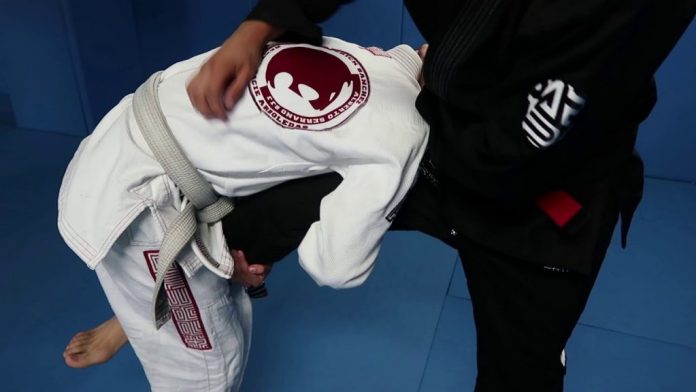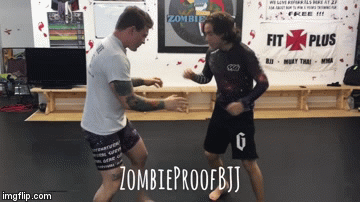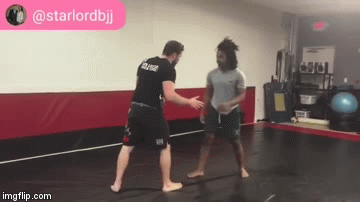
Yup, it is another leg locks article. This one, however, is going to be a bit different. Let’s change up the normal routine of either looking specifically at attacking or defending leg locks. For that matter, we’re even going to abandon the Ashi Garami discussions this time. Instead, it’s time to look at leg locks as a counter-attacking weapon. This is going to oppose the major philosophy of today that a leg lock requires control and positioning to work. Well, not really oppose but I kind of bend this philosophy. After all, counterattacks are meant to be quick and decisive, using the element of surprise. There’s no element of surprise in methodically setting up Ashi Garamis for 5 minutes.
Counter-attacking is a somewhat advanced skill in Brazilian Jiu-Jitsu. It takes a good understanding of attacks, to begin with. Furthermore, it takes an understanding of what exactly an opponent is doing. Even more importantly, for counterattacks, you need to know what your opponent is planning to do. This takes time and experience, which is why we consider counters to be an advanced skill. That said, leg locks fit the definition of counter-attacks perfectly. They’re fast working submissions that can result in a lot of pain in an instant. Also, entries from positions of apparent disadvantage are a defining trait of leg locking submissions. All in all, they can be the perfect counter-attacking tool in many grappling situations.
One such situation where a leg lock can do wonders is in countering takedown attempts. Countering takedowns with submissions is not an easy thing to do in BJJ. The reason for this is that you need good positioning before you go for a submission. Since ground fighting is where BJJ is at its strongest, it means a lot of time and effort is required in order to get a submission. This pretty much goes again the principle of counter-attacks, which need to be fast and decisive. So far, front headlock chokes and/or the Kimura trap are the top options to defend against wrestling takedowns like a single leg. Leg locks offer a whole new counter-attacking dimension to them.
If you’re looking for something a bit different from Danaher’s concepts, it’s time to check out what Eddie Cummings is up to. Danaher’s star student is taking the leg locks game further than anyone before Pick the “Eddie Cummings Ashi Garami Seminar” digital instructional for an in-depth guide to attacking and defending leg locks!
Counter Attacking With A Leg Lock
Despite the heavy use of leg locks in the modern grappling world, a true understanding of them is really rare. With the exception of the Danaher Death Squad and a few other standouts, like Craig Jones, people have no idea what they’re doing most of the time. know what you are doing. Mastering leg locks takes years and experience. This is exactly what you can use to your advantage.
Instead of going for the complete leg lock experience, look into them as counter-attacks. That way you can limit your focus to just a position or two and a couple of submissions. that said, you’ll be spared from learning entries since the point of a counter-attack is to use the position you’re into. This will shorten the learning curve of leg lock submissions significantly. it will also provide you with a counter that people won’t be able to defend. Because let’s face it, leg lock defense is even more poorly understood than the attacks.
Finally, remember that BJJ is full of exceptions. Even if you hit a counter leg lock perfectly, you might not end up finishing an opponent. They might just be crazy flexible, or they might be one of the rare ones that can defend in time. So even when you counter, make your final countering position be one that can offer transitions to other attacks. The specific counters that we’ll cover today offer precisely that.
The Anti-Takedown Game
Once again, in order to defend a move, you need to know a move. However, when you’re countering a move, you do not need a deep knowledge of it. When you’re defending, usually the best approach is to prevent an attack from happening. Even if an attack happens you’ll be looking to disrupt it while it’s happening. In defending takedowns, it is the most common blueprint people follow.
When you counter, you need a different approach. For one, you need to know what the point of the takedown is, rather than the technique of the move itself. Furthermore, you need to know where and when the takedown is going to end. This is going to allow you to let your opponent work until a specific point. What this allows is for confidence to build in your opponent, who’ll think they’ve got you defenseless.
In order to be able to counter takedowns, you need to know their weak spot. Every takedown has a weak spot you can exploit, in terms of leg locks as counters. These weak points are not in the techniques of wrestling themselves but in their relation to the sport of BJJ. Just like doing an Ippon Seio Nage can land you in a rear naked choke, going for certain takedowns opens up certain counters.
The key elements are proper timing and invisible Jiu-Jitsu. If you time a takedown counter wrong you’ll end up on your back, no doubt about it. Timing your counter means positioning yourself during the opponent’s attack. This is invisible Jiu-Jitsu at its best.
Calf Slicer
The takedown we’re going to focus on today is one of the most utilized moves in all grappling martial arts – the single leg. It is part of the basic BJJ and wrestling curriculum and works at all belt levels. As such, plenty of defenses and counters already exist, but none are as effective as leg locks.

To begin with, a legal one for all you IBJJF die-hards out there. Of course, you’ll need to be a brown or black belt for this, but we did mention counterattacks are advanced, right? As your opponent shoots for a single leg, make yourself look busy but do not truly defend their attempt. Allow them to get your leg in between their legs. Do not, however, let them keep their head on the inside. That’s the only thing you need to worry about for now.
Once their head is on the outside, you can focus on your counter. The higher up your leg they are, the better for you. Use the leg that’s between your opponent’s legs and hook the near side leg. AS you do that, catch your shin with your hand, similar to a triangle setup. All you need to do now is actually fall back on your back and triangle your legs. You’ll end up right in the Truck position with a calf slicer ready to go.
And, in the case things do not work out you always have a transition to the back, or, if rules allow it, to the Twister.
Imanari Heel Hook
Now, let’s explore some “darker” aspects of leg locks. You could also use the dreaded heel hook submission to finish a fight after being caught in a single-leg takedown. Once again, it will only seem as if you were caught and you’ll keep your options open at the end.

This counter is actually much more dependent on correct timing. You need to anticipate where the takedown is going to end and use that momentum to get into a counter. The best way to finish a single leg is by pilling the leg and applying forward pressure on the thigh. This will inevitably get you down, but also open up an Imanari roll. Since your leg is already up between the legs of the opponent, all you need to think about is hooking their near side leg with your arm. From there on, you’re a simple roll into a honey hole and an inverted heel hook.
The beautiful thing is that if you mess it up somehow, you can go in two main directions, You can keep playing the leg lock game by transitioning into Ashi Garami controls (like 50/50) and different leg locks. Or, you could simply go into a leg drag and get a sweep and a pass with ease.


![Darce Choke Encyclopedia – Origins, Mechanics and Variations [2024] BJJ, choke, Brabo, BJJ Darce Choke, D'arce Choke, Darce BJJ Choke](https://bjj-world.com/wp-content/uploads/2017/11/JungPoirierLeeYahoo-218x150.jpg)









![Mastering Control From Top Position Trent Hidlay DVD Review [2024] Mastering Control From Top Position Trent Hidlay DVD Review](https://bjj-world.com/wp-content/uploads/2024/11/control-from-top-position-trent-hidlay-dvd-review-218x150.png)
![Foot Sweep the World Dainis Nguyen-Huu DVD Review [2024] Foot Sweep the World Dainis Nguyen-Huu DVD Review](https://bjj-world.com/wp-content/uploads/2024/11/foot-sweep-the-world-dainis-nguyen-huu-dvd-review-218x150.png)
![Front Headlock and Turtle Escapes Brian Glick DVD Review [2024] Front Headlock and Turtle Escapes Brian Glick DVD Review](https://bjj-world.com/wp-content/uploads/2024/11/headlock-and-turtle-escapes-brian-glick-dvd-review-218x150.png)
![Basic Closed Guard Jasmine Rocha DVD Review [2024] Basic Closed Guard Jasmine Rocha DVD Review](https://bjj-world.com/wp-content/uploads/2024/11/basic-closed-guard-jasmine-rocha-dvd-review-218x150.png)
![Don’t Stand Up Chris Wojcik DVD Review [2024] Don't Stand Up Chris Wojcik DVD Review](https://bjj-world.com/wp-content/uploads/2024/11/dont-stand-up-chris-wojcik-dvd-review-218x150.png)
![EMU Guard 2.0 Benjamin Power DVD Review [2024] EMU Guard 2.0 Benjamin Power DVD Review](https://bjj-world.com/wp-content/uploads/2024/11/emu-guard-2-0-benjamin-power-dvd-review-218x150.png)
![Understanding The Distance On Top Gui Mendes DVD Review [2024] Understanding The Distance On Top Gui Mendes DVD Review](https://bjj-world.com/wp-content/uploads/2024/10/distance-on-top-gui-mendes-dvd-review-324x235.png)



![Crossing and Spinning Steps To Attack Israel Hernandez DVD Review [2024] Crossing and Spinning Steps To Attack Israel Hernandez DVD Review](https://bjj-world.com/wp-content/uploads/2024/09/spinning-steps-to-attack-israel-hernandez-dvd-review-100x70.png)

![Jett Thompson Master Ankle and Aoki Lock DVD Review [2024] Jett Thompson Master Ankle and Aoki Lock DVD Review](https://bjj-world.com/wp-content/uploads/2024/09/jett-thompson-master-ankle-and-aoki-lock-dvd-review-100x70.png)

![Giancarlo Bodoni DVD Bundle Essential Connections Full Review [2024] Giancarlo Bodoni DVD Bundle Essential Connections Full Review](https://bjj-world.com/wp-content/uploads/2024/09/giancarlo-bodoni-dvd-bundle-essential-connections-100x70.png)

![Intro To Hip Mobility for Guard Players Joshua Presley DVD Review [2024] Intro To Hip Mobility for Guard Players Joshua Presley DVD Review](https://bjj-world.com/wp-content/uploads/2024/09/hip-mobility-for-guard-joshua-presley-dvd-review-100x70.png)

![Old School BJJ Ricardo Cavalcanti Fundamentals DVD Review [2024] Old School BJJ Ricardo Cavalcanti Fundamentals DVD Review](https://bjj-world.com/wp-content/uploads/2024/09/old-school-bjj-ricardo-cavalcanti-dvd-preview-100x70.png)

![Eoghan O’Flanagan Bundle Down Right Sloppy Jiu-Jitsu Review [2024] Eoghan O'Flanagan Bundle Down Right Sloppy Jiu-Jitsu Review 2024](https://bjj-world.com/wp-content/uploads/2024/09/down-right-sloppy-jiu-jitsu-eoghan-oflanagan-bundle-100x70.png)


![EMU Guard 2.0 Benjamin Power DVD Review [2024] EMU Guard 2.0 Benjamin Power DVD Review](https://bjj-world.com/wp-content/uploads/2024/11/emu-guard-2-0-benjamin-power-dvd-review-100x70.png)



![Advanced Immortal Clinch Matt Brown DVD Review [2024] Advanced Immortal Clinch Matt Brown DVD Review](https://bjj-world.com/wp-content/uploads/2024/09/advanced-immortal-clinch-matt-brown-dvd-review-100x70.png)

![Jeff Higgs Self Defense Guard BJJ DVD Review [2024] Jeff Higgs Self Defense Guard BJJ DVD Review](https://bjj-world.com/wp-content/uploads/2024/09/jeff-higgs-self-defense-guard-bjj-dvd-review-100x70.png)



![Countering Triangles And Omoplatas Adam Mazin DVD Review [2024] Countering Triangles And Omoplatas Adam Mazin DVD Review](https://bjj-world.com/wp-content/uploads/2024/10/countering-triangles-and-omoplatas-adam-mazin-dvd-REVIEW-100x70.png)